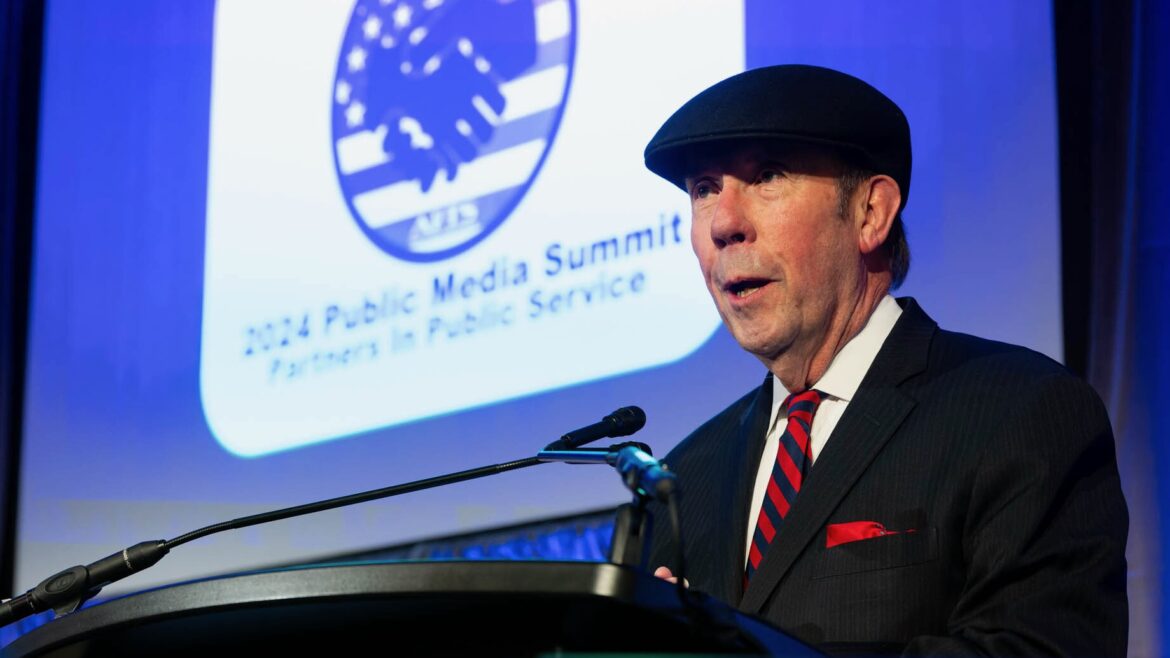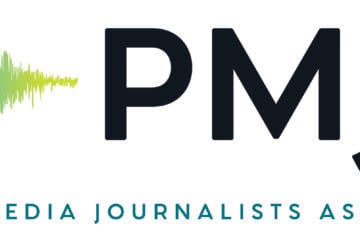APTS’ Patrick Butler recalls how faith in public media’s mission shaped his advocacy

Phil Humnicky
Pat Butler speaks to attendees at the 2024 Public Media Summit in Washington, D.C., Monday.
In delivering his final annual address Monday as president of APTS, Patrick Butler recalled the rocky start to his tenure as public TV’s chief advocate in Washington, D.C.
In early 2011, lawmakers in Congress and state legislatures were looking to slash federal funding for public broadcasting. Membership in America’s Public Television Stations was declining. And, in a meeting with other public media leaders, Butler discovered that many believed the threats to abolish CPB funding would be realized.
Butler, who plans to retire sometime this year, told attendees of the 2024 Public Media Summit in Washington that he came into his job with faith in public TV’s commitments to lifelong learning and public service — and he was determined to make his case for federal funding through stories about the value of the services stations provide to their communities. The son of a minister, Butler described how broadcasts of his father’s sermons drew him to a career in media, and his faith in those who will continue the “noble work” of public media’s service to the nation.
Butler began his speech Monday afternoon by explaining why he was wearing a beret — a distinctive style choice in buttoned-down Washington, D.C. “Please pardon my cap. I am recovering from minor surgery,” he said. “I’ll be okay, but I’m trying to recover in style.”
The speech has been edited from prepared remarks.
When I joined the public media family 13 years ago, the Tea Party had just taken over the House of Representatives, intent on repealing Obamacare and reducing all government spending.
A bipartisan budget commission had just recommended abolishing the Corporation for Public Broadcasting. Controversies of public media’s own making would soon lead to a House vote to defund NPR. The program that had funded infrastructure improvements for public broadcasters for 60 years was about to be eliminated.
The 34 states that provided financial support to public media were cutting $100 million from their collective public broadcasting budgets. And APTS itself was hemorrhaging membership, losing stations in some of America’s largest cities and most populous states, as well as smaller markets.
At this very conference in 2011, a legend in our business stood on this stage and said he smelled defeat. And at a council of elders gathered to assess all these troubles, the chairman of the board of CPB asked for a show of hands of those who thought our federal funding would still be there in five years.
One hand shot up — this one.
While new to the family, I had faith in you: faith that you were doing something worthwhile, something essential, something unique in the life of this country.
It wasn’t only your iconic television programming. It wasn’t even your legendary commitment to lifetime learning. It was, instead, your work as partners in public service with governments and other institutions which share your missions of education, public safety and civic leadership.
I was confident that if we performed those services well enough and told our story often enough, we could convince people of every political persuasion that a modest investment in you is a smart investment in America itself.
Five years later, 10 years later, 13 years later, that faith has been rewarded. Federal funding is still flowing — at record levels — to America’s public broadcasters.
Congress has enacted a new infrastructure investment program for public media, nearly three times as large as the one it replaced. When COVID struck and the economy imploded, Congress provided $250 million in emergency financial assistance to America’s public media. This year, 40 state governments will commit a record $365 million to support public broadcasting. And, as we’ll see this afternoon, progressives like Governor Wes Moore of Maryland and conservatives like Congressman Jake Ellzey of Texas are united in their admiration of your service to the American people.
Working together, with Democratic and Republican governments alike, we have preserved the public funding that makes public media possible. This has been a principal mission of America’s Public Television Stations since our incorporation 45 years ago.
But it’s not the only one.
Our charter states that this association should:
- “Provide planning, research and technical assistance to stations,”
- “Communicate the benefits of public media to the public we serve,” and
- “Offer solutions to the complex problems of the communications environment.”
With this mandate, we helped dozens of public television stations participate in the first-ever FCC auction of broadcast spectrum — and reinvest millions of dollars in enhanced local programming and services.
We renewed long-term agreements with cable, satellite and telephone companies to carry all of our signals to more than 80 percent of our audience. We helped stations in almost 30 markets make the transition to the NextGen TV broadcast standard. We demonstrated the power of datacasting to enhance public safety, in partnership with the Department of Homeland Security. We began an exciting exploration of new spectrum-based service and business opportunities in partnership with some of the most innovative companies in the world. We guided stations through the complexities of the Payroll Protection Program — and kept 20,000 public broadcasters on the job during COVID. And we created this Public Media Summit, to examine all the strategic issues facing our system with all the leaders of that system.
We’ve done all of this, and more, with a staff of 15 people. And because this staff has done so much so well, as of last year the highest percentage of public television stations in our 45-year history were members of this association. …
For all the progress we’ve made, we know that our work is never finished.
In our mission of advocacy alone, our audience changes dramatically with time.
Of the 535 senators and representatives serving in Congress in 2011, only about 120 remain today. No governor then is governor now. The five seats on the FCC have been held by no fewer than 13 people in the last 13 years. And every election brings about 2,000 new people to America’s state legislatures.
Through such transition, the work of educating and advocating for public media must be constantly renewed.
Just months ago, a new chairman of the House Appropriations subcommittee responsible for most of our funding drafted legislation to eliminate every penny of that funding.
The Senate Appropriations Committee, by happy contrast, reported a bill that would give us the same record level of financial support we achieved last year — and did so with an overwhelmingly bipartisan vote of 26–2.
The House and Senate are in the final stages of negotiating the entire federal budget, and we are hopeful that the Senate’s proposal for our funding will prevail.
We had hoped to hear about the progress of those negotiations today from the vice-chair of the Senate Appropriations Committee, Sen. Susan Collins of Maine. Unfortunately, Sen. Collin’s mother is not well, and the Senator is … with her mother in Maine.
Remember this: if Republicans win control of the Senate in November, Sen. Collins will chair the Senate Appropriations committee. And she last appeared at this Summit, in 2019, it was to accept our Champion of Public Broadcasting Award.
The perennial funding battle we wage in Congress and in state capitols is only one of the challenges facing public media today. Technology is revolutionizing our business. Traditional broadcasting serves fewer people every year.
Americans streamed 21 million years’ worth of television programming in 2023, and there’s no going back. Competitors for our viewers’ time are some of the largest and richest companies on the planet.
Netflix spent $17 billion last year producing original content for its customers. That’s more than four times the annual revenue for all of public media combined. Amazon and Apple are even bigger companies, and their ambitions in our business may be even greater.
To survive in this forbidding new media world, we must both reinvent ourselves and remember who we have always been. We have to make streaming easier for our local viewers. We have to modernize our infrastructure and maximize our efficiency. We have to take advantage of artificial intelligence and every other innovation that may benefit our system. And we have to make the most of the spectrum we steward, fully embracing the NextGen TV broadcast standard, building new platforms of public service and new sources of spectrum-based revenue, for your stations and our system.
We also have to keep faith with our historic mission of educational, noncommercial, local and universal service to the American people.
In my first speech to this audience long ago, I said: “We are in the business of creating a well-educated, well-informed, cultured and civil society fully capable of meeting its responsibilities as the oldest and greatest democracy on earth.”
Despite the proliferation of players in the media world since then, that mission statement remains ours alone.
No one else — not Netflix, not Amazon, not anybody — will teach a child, follow the legislature, protect people in trouble, or chronicle life in hometown America as public television does.
I have faith that the more of this work we do, and the better we do it, the greater our prospects will be to succeed in the new media marketplace — and to maintain the support of our government funders.
Just a few weeks ago, the Senate Judiciary Committee held a hearing with the heads of the largest social media companies. Everyone on that committee was concerned about the safety of our children in a virtual universe where virtually anything goes.
Simply offering a safe place for children to be educated and entertained is suddenly a social benefit embraced across the ideological spectrum. And that’s what we do.
This kind of trust is an incalculable advantage for us, one we have spent half a century earning, and one that will serve us well no matter how the media world evolves. It’s reassuring to know that our friends at Sesame Workshop are still making kids “smarter, stronger and kinder” every day. And PBS remains committed to building a better America, one kid at a time.
Public television still provides the only preschool education there is for more than half of America’s children. This work alone would fully justify the investment which our federal and state governments make in us. But it is only the beginning of the service we provide to the American people.
In recent years, we’ve helped our communities cope with crises ranging from opioid addiction, to racial injustice, to a deadly pandemic. And our reputation as resourceful Partners in Public Service continues to grow.
Public television stations are partnering with:
- Eight Nevada school districts, covering 75,000 square miles, to enrich the education of 126,000 far-flung students;
- The California Office of Emergency Services, to provide early earthquake warnings to 40 million people who frequently need them; and
- The state legislature of Ohio, to bring transparency and accountability to the work of government.
There are hundreds of examples of such partnerships, in all 50 states. And we do all this without any expectation of profit or praise.
We don’t measure our success by audience ratings but by the community impact of the services we provide. And we serve people and places of little interest to our friends in commercial media.
Since the Bulova Watch Company aired the first television commercial, on NBC in 1941, advertisers have focused more and more intently on selling their wares to people between the ages of 18 and 54 — and the more affluent the better. It’s such a good business that even the streamers have reinvented it as the FAST channel: Free Advertiser Supported Television.
But it’s not our business.
Viewers younger than 18 and older than 54 are special audiences for us. And some of the most important things we do aren’t even on television.
The only way to ensure that our services reach every American, of every age, everywhere is through a growing federal investment in public media. That’s not just our opinion. It’s the conclusion of the government’s own watchdog agency, in a study commissioned by Congress itself.
This is the urgent, compelling message that a promising new generation of public media leaders must carry to Capitol Hill this week. You are that generation.
Of the 160 general managers running America’s public television stations when I arrived 13 years ago, only 22 are still serving. Forty-eight percent of stations have changed general managers in the past four years alone. Women and people of color have filled 25 percent of those openings. That’s encouraging progress. But it’s not enough.
We need as much diversity of all kinds as we can get, because America’s public media must be profoundly public — and comprehensively American — if we are to serve our country as we should.
Sixty years ago, the philosopher Marshall McLuhan famously declared that “the medium is the message,” reasoning that the essence and importance of any medium transcends its content and is defined by its purpose and its impact on society. The purpose of public media is public service.
In our time, perhaps the most important public service we can render — the most useful impact we can have on our society — is to help our people become better citizens and help our country get along with itself.
We have reached a point where our divisions are so deep, our discourse so rancorous, our understanding of basic facts so contentious, and our very institutions of government so poorly understood that our democracy itself seems endangered.
No less an authority than the father of our country warned in his farewell address of a destructive spirit of partisanship which, in his words, “agitates the community with ill-founded jealousies and false alarms, kindles the animosity of one part against another, foments occasionally riot and insurrection.”
President Washington’s prescription for such civic ills was a well-informed citizenry. He wrote: “Promote, then, as a matter of primary importance, institutions for the general diffusion of knowledge. In proportion as the structure of government gives force to public opinion, it is essential that public opinion should be enlightened.”
That’s what we do and we do it very well.
For 21 consecutive years, public television has ranked as the most trusted institution in America. We are the oasis in the growing news desert, the modern public square, the Lyceum of which E.B. White spoke in his famous letter to the Carnegie Commission defining the goals of public media almost six decades ago. …
All of us in public media have a special role to play in seeking reconciliation among our fellow citizens, nurturing a decent respect for differing points of view and demonstrating how a civil society of free people is supposed to work. No one is better suited to this mission than we are.
There are hundreds of willing partners, and millions of frustrated citizens, who will be eager to join us in a search for common ground on which all of us can stand.
This has been my calling for more than half a century, and I have been fortunate to pursue it with some of the finest people of our era.
Fortunate to have been able, late in my life, to work with all of you to save a cherished institution dedicated to this same mission.
Fortunate, most of all, to come home from these labors to a loving family, who mean everything to me, and who have joined us today for my last hurrah.
My career in the media business began almost 70 years ago, at a little radio station in South Pittsburg, Tennessee.
My father was a minister, and he had a 15-minute program on WEPG – 910 on your AM dial – delivering a brief sermon every Sunday morning. My brother Mike and I would open the program reading scriptures from the Bible. Mike, who was older, got the more complicated verses. I got the shorter ones. “Jesus wept.” “Pray without ceasing.” It was enough to give us a passion for media, if not for the ministry.
We rigged up our own television studio in a little storage room behind our garage. Our camera was a floor lamp and a cardboard box, our microphone the nozzle of a hose.
The news director of WEPG ripped a story right off the AP teletype machine for us to use in our homespun broadcasts. With this single piece of wire-service copy, we covered the Suez Canal crisis of 1956 – for years – as we harbored hopes of one day making our own mark on the wider world.
I’m sure many people in this room have a similar story about their own humble origins in broadcasting and their ambitions to channel its power for good, perhaps even for salvation.
To think that we could dream such dreams and make them come true, is to understand just how special our country is, and how honored we are to serve it. Even when it’s hard. Especially when it’s hard.
In a nation divided, we build community.
To bitter debate, we bring civility.
To an anxious people, we provide safety.
To a coarsening society, we offer culture.
Where intolerance looms, we embrace diversity.
To those who have little, we impart the priceless gift of education.
In the darkness of disinformation, we shine the liberating light of truth.
With great confidence that you will continue this noble work, and in the firm belief that your country will support you in that work, I now close my career as I began it, quoting Scripture.
“I have fought the good fight. I have finished my course. I have kept the faith.”
Thank you for the privilege of serving you and leading you. And may God bless you all.









Thank you so much, Pat, for fighting that good fight and doing it so well on behalf of America’s public broadcasters. In my time, I always felt well supported and alerted by APTS. America is the better for having had your leadership and sense of mission.